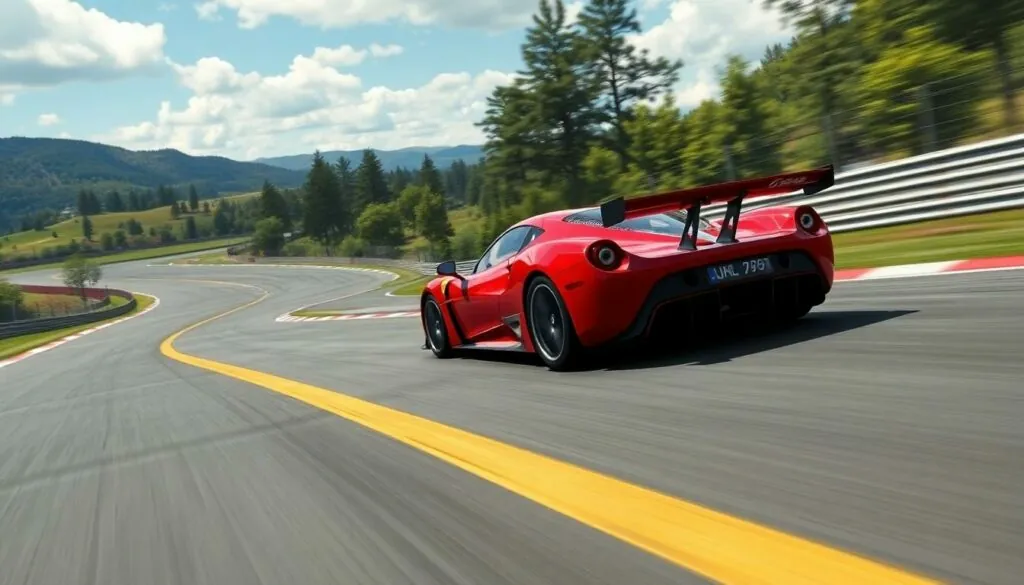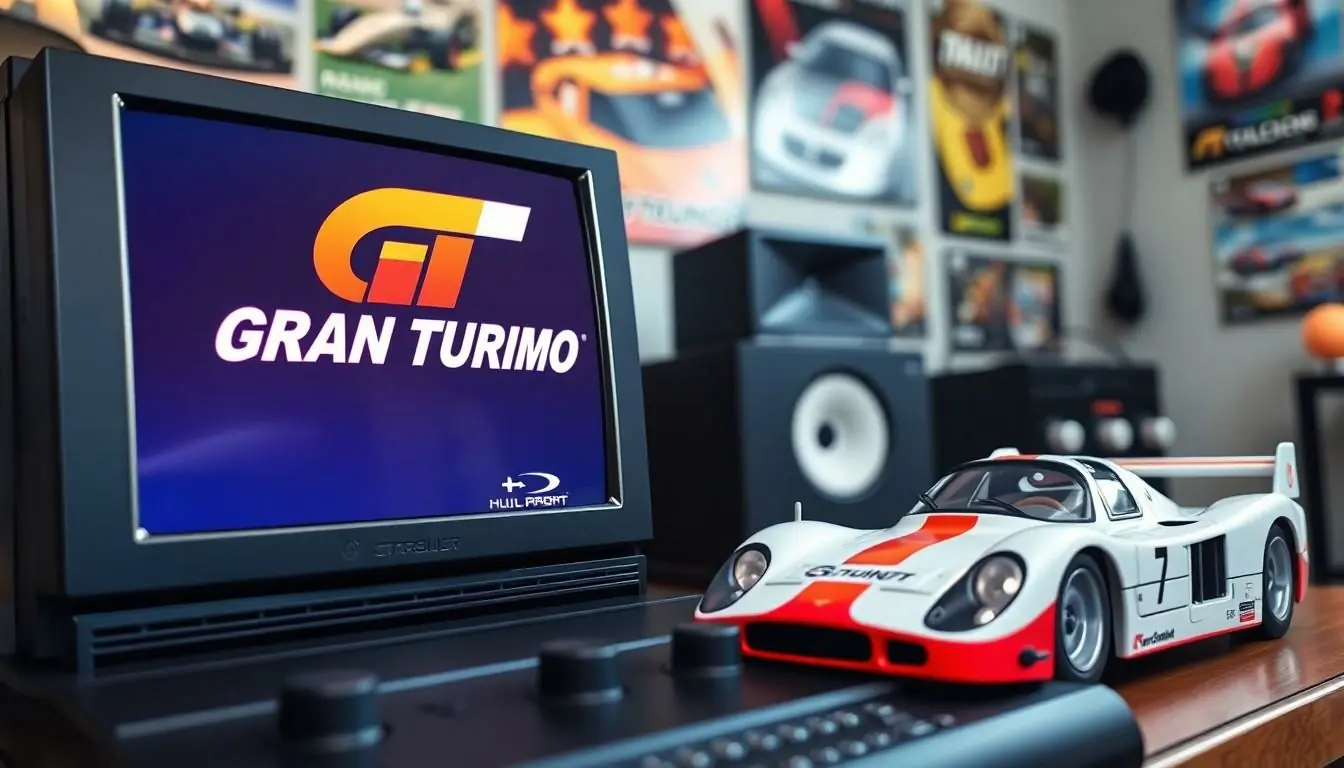Table of Contents
ToggleIn the world of racing games, few titles have left as big a mark as Gran Turismo. With its stunning graphics and realistic driving mechanics, it took players on a thrilling ride when it first hit the shelves. But do you know when this iconic game made its grand debut? Spoiler alert: it was a game-changer, quite literally.
Overview of Gran Turismo Series
Gran Turismo launched in December 1997, setting a benchmark for racing simulations. It introduced players to a meticulously crafted world featuring over 150 cars. This robust collection allowed players to experience a range of vehicles from manufacturers like Ferrari, Toyota, and Porsche.
Graphics in Gran Turismo stood out, showcasing stunning visuals for the time. Its commitment to realism transformed players’ driving experiences, simulating everything from tire wear to engine performance. Players found themselves immersed in meticulously detailed environments, enhancing the overall gameplay.
The game employed innovative physics and driving mechanics. Each car handled differently, encouraging players to adapt their driving styles. Success required mastering these mechanics, which added depth and replayability.
Gran Turismo not only captivated individual players but also built a community. Online features in later iterations enabled competitive racing on a global scale. Players shared tips, car tuning strategies, and race results, fostering a vibrant fanbase.
Subsequent titles in the series expanded on the original’s foundation. Gran Turismo 2 launched in 1999, introducing even more cars and tracks. This commitment to evolution kept the series fresh and engaging, ensuring its place in gaming history.
Critical acclaim followed the Gran Turismo franchise for its contributions to the racing genre. Many viewed it as a gold standard for driving simulations. The series’ impact extended beyond gaming, influencing automotive culture and sparking interest in car collecting.
Through consistent innovation, Gran Turismo continues to celebrate automotive enthusiasm and the thrill of racing.
Gran Turismo 1 Release Date
Gran Turismo debuted in Japan on December 23, 1997. This release marked a pivotal moment for racing simulations and the gaming industry.
Significance of the Release Date
The December launch positioned Gran Turismo to capture the holiday gaming market. Players experienced a revolutionary racing title that set new standards for graphics and realism. Competing games at the time struggled to match its focus on detailed car models and accurate driving physics. The timing bolstered sales, contributing to its immediate popularity. Gran Turismo’s arrival signaled the start of a new era, influencing future racing games and establishing a lasting legacy in the genre.
Initial Reception of Gran Turismo 1
Upon its release, Gran Turismo garnered widespread acclaim from critics and players alike. Review scores reflected its impressive graphics and engaging gameplay, praising the extensive car collection and attention to detail. Players welcomed the realistic driving mechanics, noting the need to adapt their driving styles. Sales data showed the game quickly became a bestseller, moving over 10 million copies worldwide. The initial reception laid a strong foundation for future installments in the franchise, solidifying its place in gaming history.
Features of Gran Turismo 1
Gran Turismo 1 revolutionized the racing simulation genre with its unique features. Players experienced an unparalleled level of detail and realism.
Gameplay Mechanics
Gameplay mechanics focused heavily on driving physics, requiring players to adjust their techniques for better performance. Cars exhibited distinct handling characteristics, reflecting their real-world counterparts. Players utilized an extensive tuning system, allowing customization of horsepower, suspension, and tires. Each decision influenced race outcomes, adding depth to the driving experience. The game also featured a variety of race types, including time trials and endurance races. Challenges increased as players progressed, ensuring consistent engagement.
Graphics and Sound Design
Graphics showcased cutting-edge visuals for the time, delivering beautifully rendered car models and environments. Each vehicle displayed intricacies, providing an authentic look and feel. Populated tracks featured realistic backgrounds, enhancing immersion. Sound design complemented the visuals through accurate engine sounds, tire squeals, and collisions. Players enjoyed a truly immersive experience with dynamic audio elements. Visual and audio components combined to create a memorable atmosphere, elevating the overall gameplay.
Legacy of Gran Turismo 1
Gran Turismo 1 left a significant mark on the racing game genre, compelling developers to raise their standards in terms of realism and gameplay mechanics.
Impact on Racing Games
Gran Turismo 1 transformed the racing game landscape with its groundbreaking graphics and physics. Players experienced a level of realism that few games offered at the time. Detailed car models reflected real-world performance, allowing players to connect with vehicles on a deeper level. Enhanced driving mechanics demanded strategic adjustments to control individual cars effectively. Realistic simulations of tire wear and engine performance introduced challenges that required skillful driving. Competitors struggled to match the game’s depth and attention to detail. Over 10 million copies sold globally underscored its popularity and influence on future racing titles.
Influence on Future Installments
The success of Gran Turismo 1 set the stage for subsequent series entries. Future installments built upon the foundation established by the original game. Gran Turismo 2 expanded the car roster and introduced new features, including improved graphics and gameplay mechanics. Each new title incorporated player feedback, ensuring evolving gameplay and deeper engagement. Innovations in multiplayer modes came as a direct response to community demand. Through consistent enhancements, the franchise maintained its status and expanded its audience. Ultimately, the legacy of Gran Turismo 1 significantly shaped the direction of the racing simulation genre, influencing developers worldwide.
Conclusion
Gran Turismo 1’s release in 1997 marked a transformative era in racing simulations. Its groundbreaking graphics and realistic driving mechanics set a new standard that competitors struggled to match. By focusing on authenticity and offering an extensive car collection, it captivated a wide audience and established a loyal fan base.
The game’s innovative features not only enhanced gameplay but also laid the groundwork for future titles in the franchise. As a pioneer, Gran Turismo 1 influenced the direction of racing games for years to come, ensuring that the thrill of driving and automotive passion remains at the forefront of gaming experiences. Its legacy continues to inspire developers and engage players, solidifying its place in gaming history.


